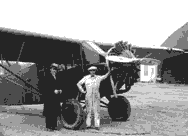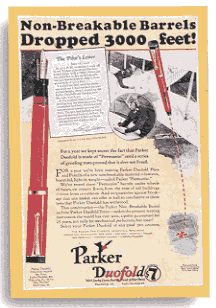 May 1927, and Charles Lindberg achieves the first solo flight across the Atlantic, igniting the world's fascination with flying machines and the endless possibilities of the future. World records for speed and distance were being broken on a regular basis. Amelia Earhart followed one year later in June 1928 to become the first woman aviatrix to fly across the Atlantic.
May 1927, and Charles Lindberg achieves the first solo flight across the Atlantic, igniting the world's fascination with flying machines and the endless possibilities of the future. World records for speed and distance were being broken on a regular basis. Amelia Earhart followed one year later in June 1928 to become the first woman aviatrix to fly across the Atlantic.
Rewind to 1921, when the Parker Pen Company introduced their new oversize Duofold fountain pen, with a patented bright red design with black ends which "Rivaled the beauty of the Scarlet Tanager". The Duofold pen was hugely successful, and when unbreakable Permanite was added in 1926, demand grew so rapidly that the war for market share exploded.
The primary combatants were Sheaffer, with their oversize Lifetime flat top. Waterman stubbornly maintained hard rubber, making it available only in black, red or red/black mottled and ripple patterns. Wahl Eversharp's oversize Personal Point in 1929 eventually led to the Doric in 1930.
Fountain pens were big business, and serious advertising campaigns were launched to keep brand names in front of the world wide market. What better way to keep the public's attention than to ride the excitement of those modern flying machines?
Kenneth Parker purchased this plane in 1928 for $ 18,230. Extra specialist equipment included a turn and bank indicator, so the pilot could determine changing direction in the dark and extra large landing lights in case of a roaming cow on the local pasture landing strip. Unique to this plane was the ability to fold the wings flush against the fuselage. Practical for storage, but invaluable when an unexpected landing forced the plane into a field too small for take-off. The local farmer would then use his tractor, horse or mule to tow the plane down narrow country roads to a more suitable field for departure. How incredibly forward looking and clever!
November 1928 in Chicago, and Amelia Earhart christens the giant Fairchild FC2W2 monoplane "The Duofold". This was one of the most modern and powerful aircraft in its day. Coincidently, this was the same model aircraft used by Richard Byrd to fly over the Antarctic the following year; and he carried a Waterman pen. Waterman advertised this achievement in their national advertising. The Fairchild plane also flew around the world in a record-breaking twenty three days. Imagine the newspaper headlines, the excitement and the crowds at local airports whenever The Duofold flew into town. This was one of the most famous airplanes in the world...and everyone dreamed of a chance of a thrilling ride.
This aircraft had an enclosed cabin for four passengers and one pilot. Construction was metal sheeting up front around the engine and pilot cabin, metal tubing and wood framing, covered with sheet canvas. The giant 410 hp Wasp engine was capable of propelling this plane to 140 mph and climbing to an altitude of 19,500 feet. I saw this very plane recently, and it was a humbling experience. Difficult to believe that it was state-of-the-art in it's day.
 Immediately after christening, The Duofold took off on a Grand Tour of America, visiting dealers in most major cities. Within a few months as many as 2,300 guests were taken aloft for the thrill of their lives. Often flying over cities, Duofold's were dropped to demonstrate the properties of the unbreakable Permanite. Dealers would display the pen to amazed crowds, who could not buy them fast enough.
Immediately after christening, The Duofold took off on a Grand Tour of America, visiting dealers in most major cities. Within a few months as many as 2,300 guests were taken aloft for the thrill of their lives. Often flying over cities, Duofold's were dropped to demonstrate the properties of the unbreakable Permanite. Dealers would display the pen to amazed crowds, who could not buy them fast enough.
This same promotional stunt was repeated in England, with a smaller similarly decorated DeHavilland "Puss Moth" taking the place of the Duofold plane. English crowds considered this stunt a typical example of American excess, and were not overly impressed.
As further aeronautical world records were achieved in speed and long distance travel, the giant red and black Parker Duofold monoplane shared in the limelight at these events.
Many years later this aircraft was sold to an airline, flying a shuttle route from Key West in Florida to Havana, Cuba. Eventually, it is believed, the Duofold found a final resting place in the deep blue waters somewhere off Cuba, where it is now most likely part of the beautiful coral reef.


